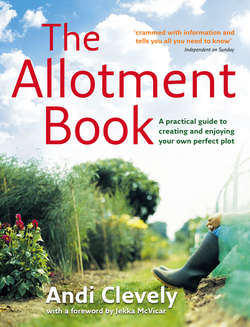Читать книгу The Allotment Book - Andi Clevely - Страница 41
TEMPORARY FRAMES
ОглавлениеYou may be reluctant to sacrifice good growing space to a structure that might be needed for only part of the year, perhaps for spring frost protection. Lightweight collapsible frames are available that can be dismantled when they are not needed. Alternatively, you could make your own from a variety of materials. For example, a large bottomless box with its top replaced by a sheet of clear plastic can cover several seed trays (on very cold nights simply spread an old blanket or sheets of bubble polythene over the top). An enclosure of straw bales covered with old car windscreens or double glazing panels makes a snug frame, and the straw can be used afterwards for mulching or as a carbon ingredient in a compost heap (see pages 116–17). Professional growers often arrange empty crates and boxes to make the frame walls, draping black polythene over the walls and floor like a pond liner, and then sheeting over the top with thick polythene (polytunnel grade).
Cold frames Although they are sometimes regarded as simple greenhouse accessories, cold frames are versatile, sometimes portable, infinitely adjustable and often efficient substitutes for a greenhouse. They are also less expensive than a greenhouse, and provide more space and greater adjustability than cloches. Easily constructed at home, they can be adapted to span a narrow bed or to fit on top of a compost heap to make a hot bed (see page 53).
At its simplest the standard frame is a four-sided box structure with a lid that slopes to shed water and opens to admit air. It is accessed from the top, via a lid that is glazed with plastic or glass, and that can be lifted or removed to adjust ventilation. The sides may be glazed or solid. Fixed frames can have a soil floor for planting, or a solid base of slabs or gravel spread over a weed-proof membrane, which is useful for housing pots and trays. A portable frame can be moved directly over a growing crop for protection until established, after which it is moved elsewhere in the same way as cloches.
SITING A COLD FRAME You usually have little choice over the position of a greenhouse on your allotment – it may be decided for you by accessibility or site rules – but a permanent frame can go almost anywhere. The traditional position is against one side of the greenhouse to avoid carrying plants far and to share some of the stored warmth (some sophisticated frames have adjustable rear panels to allow heat transfer from the greenhouse). Installing a frame on each side of the greenhouse should provide all the space you will need for protection and hardening off.
There will probably be a lot of plant movement to and from the frame, so site a freestanding version in a convenient position: placing it at the end of a nursery bed would keep all plant-raising activities together, or you might prefer a corner of a main vegetable bed to save time when planting out. Make sure the frame is easily accessible all round, and ideally not too far from your water supply. If possible, provide shelter from prevailing winds and avoid shade from overhanging trees. A frame is normally aligned so that its sloping lid receives maximum sunlight and heat, but a lightly shaded frame can be equally useful in summer to avoid scorching sensitive plants.
Covers Protective sheets such as transparent plastic film and woven horticultural fleece can be used to cover crops and exclude a couple of degrees of frost. Horticultural fleece is light and permeable, and may be left in place over the lifetime of a crop for warmth or protection from pests or diseases, floating higher as the plants grow.
Cloches Glass sheets (discarded window panes, for example) are joined with special clips (see page 146) or a home-made arrangement of clothes pegs, string or wire to make tents for covering rows or individual plants. Traditional lantern and commercial barn or tent cloches are also available. Plastic cloches and continuous mini-tunnels of film supported by wire hoops can cover a large area. Use cloches early and late in the year to add several weeks to the growing season.
SEE ALSO ▸ The greenhouse year pages 170–4 The cold frame year page 175
